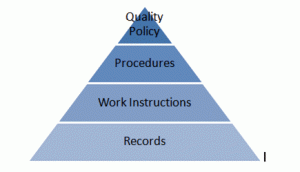Back when the ISO 9001 standard came about over 20 years ago, emphasis was on documentation and unfortunately not much on the organization’s processes. Although the standard was well intended it caused many companies to produce a chart similar to the one below:
 Most organizations had the exact same chart on their manuals and whether they understood it or not, they all knew, Procedures or SOP were level 2, Work Instructions (whether they had them or not) were level 3 and so forth. So came the notion that procedures and work instructions had to show the level, the revision, and for large corporations perhaps their division and location. So we ended up with documents numbers that went something like this:
Most organizations had the exact same chart on their manuals and whether they understood it or not, they all knew, Procedures or SOP were level 2, Work Instructions (whether they had them or not) were level 3 and so forth. So came the notion that procedures and work instructions had to show the level, the revision, and for large corporations perhaps their division and location. So we ended up with documents numbers that went something like this:
| Company Acronym | Company Division | Division Location | Type of Document | Document Level | Document Sequence | Document Revision |
| MXI (Mireaux) | CON (Consulting) | HOU (Houston) | SOP | 2 | 009 | A |
Similarly, most organizations view Document Control as the document police, and misinterpret the ISO requirements for controlling documents as ensuring that all aspects of the document properties or history was absolutely controlled. This was exacerbated by the fact that documents were in binders and hard copies had to be made. So that gave birth to the huge headers and footers, were you saw too much about a document.
Here is a good example of an old header:
| Logo | “Quoting Process” | Document # MXI-CON-HOU-SOP-2-009-A |
| Location: Houston | Standard Operating Procedure | Date: 10/22/2009 |
| Division: Consulting | SOP Level 2 | Owner: |
| Department: Quoting | Rev. A |
Here is a good example of an old footer:
| Document No. MXI-CON-HOU-SOP-2-009-A | Approved By: M. Boudreaux | Approved By Signature: | Approved By Date: |
| Next Review Date: | Reviewed By: | Reviewed By Signature: | Reviewed By Date: |
| Create By: | Created By Signature: | Created By Date: |
Let’s think about all the potential problems with these document number and header/footer model:
- Procedure number too long, hard to remember
- When the revision level is updated, now I have to change the document number. In fact now in the era of electronic documents, file names should not even be saved with the revision number, to avoid having to change document names and links every time a new revision is released.
- What if the CON division–which stands for consulting, decides that now they are also going to be training? Now all procedures have to be updated?
- What happens if Mireaux decides to relocate from HOU –Houston- to Austin, will procedures change to AUT? Or what if the procedure is so good; corporate decides it should be used by all locations, would it now be ALL instead of HOU?
- What happens if the President (or whomever is required) is not available to sign the document, would the document not be released until their signature is actually obtained?
Essentially, just too many variables that tie the organization’s hands and speed of execution –basically adds red tape- rather than allow it to concentrate on the contents of the document or on their core business.
So what number should documents really have?
Well, that is a good question and it depends on your business size and processes. In order to proper answer the question let me answer these two questions: “Are document numbers really needed? What if we start calling documents by their name?”.
The answer is no, we don’t really need document numbers in a simple situation but as processes get larger or more complex, then document numbers help keep things organized. We could easily call a few procedures by their name, but once we go over 10 procedures perhaps, remembering their name may be a little enduring.
The ISO 9001 standard does not require that documents have a number, it simply requires that organization implement a document control process by which documents can be controlled. In one of the companies I helped implement ISO 9001, they were so small and had less than 10 combined core and support procedures. We all knew exactly the name of each procedure. They were saved on the directory with their name as the file name and posted on the Web-Based QMS with their name. We did however add procedure numbers –in case somebody asked- but they were very simple: P1.1, P1.2, P1.3, and so forth. The procedure number was just a mere formality rather than a necessity. Just a way to give documents a sequence.
Could that work for another company? Not necessarily. When you have less than 10 procedures, looking at a directory with file names is rather simple, however when you have more than 10, say 15, 30, or more, looking at a directory with a bunch of file names alone, could give you a headache. Not just because the amount of words, but because you may have procedures that have very similar titles. Here is where having procedure numbers help. With the help of windows explorer, you can now add tags, titles, and subjects to document properties thus making it easier to sort your documents. Obviously if you have documents electronically, then your system you allow for adding various variables, including document number and title and the ability to sort or filter.
Overall, keeping a document-numbering system that is easy to use, easy follow and that will not require updating every time the document is updated is important. I usually recommend my clients to start with the company initials and a P for procedures and then a numbering sequence that starts with 001 or 100 depending on whether the document is a core business process or support process. So we end up with something like this:
- MXP-001, MXP-002, etc.
- MXP-101, MXP-102, etc.
If you are not sure whether a document may be a support process or core, or if your company changes names often or may change names in the future, then just go with the little company example: P1.1, P1.2, P1.3, etc.
What signatures are needed on procedures?
Again, we have another question for you: “Does a signature make a procedure better?”
No
Exactly. Signature are not really needed in procedures unless your own Document Control process requires it, in which case, you should take another look at your Document Control processes and procedures. The ISO 9001 standard requires that document be controlled and their revision controlled. But it does not specifically ask that the document originator, the reviewer and the approver sign the document. In fact, there is no requirement that says every document should show who originated it, who revised it and who approved it. In some organizations, documents have to be reviewed and approved by multiple people, so it would be rather complex to try to show all names in a procedure, let alone in the footer of the document.
I guess somebody thought that it would be a good idea to show authorities in the document, to give it more weight. While that thought may have some merit, in principle a controlled document or specifically a procedure, should be followed and adhere to by company employees regardless of whether the President signed or not. As long as a procedure was approved and released through the established procedures, then the document itself does not need to tell me the history behind the approval.
This brings us to highlight the benefits of an electronic management system. By posting a document electronically, anyone who downloads or opens the document is reading the latest approved copy. In electronic systems, access for posting documents or accessing file folders is extremely restricted, so only a few people with authority can post the document there. Usually, when a document is posted on the system, it has already been reviewed and approved. This is where you can see the true benefits of an electronic management system, as opposed to simple share file folders were everyone has access to view the contents of the folder. If there is any networking glitch, the person could read/write access to the folder and modify the document. This would not happen in an electronic Quality Management System, where the administrator has special rights and software capabilities that allows them to post revised documents to the server. However, that is a subject for another article.
Lastly, if you still have a paper-based system, or if due to the nature of your business you are required to keep hard copies of documents in certain places, simply ensure that your documents have a date or revision and an adequate name and number. I also encourage to put a name of the person who is either responsible for the procedure or document, or responsible for starting the review process -should anyone decide to update the document.
My documents typically have this header:
|
logo
|
MXP-101
QUOTING PROCEDURE Revision: 10/22/2009
|
And this footer:
Comments, questions or suggestions, e-mail:Miriam Boudreaux
What is the auditor looking for?
Another great question. What is the auditor looking for in the procedure or document? Would he/she ding me if the signatures are not present? Would he give me a nonconformity if the approval date is not there? Would he give us a finding if the revision letter is wrong?
Number one, the auditor is not out there to get you –or at least he should not be. The auditor is mainly there to see if your system conforms to the requirements of the ISO 9001 standard and your own requirements. So he is there mainly to look at the contents of the procedure and assessing whether it conforms to the ISO 9001 standard or any other standard or requirement.
However, this explains the reason why many auditors may not have said anything about your system of signatures. They are not there to judge your process –although good auditors usually point out opportunities for improvements. So if your process is rather complex or outdated, an auditor may not say much about it, one because he is not judging your means, and two because he may not offend somebody who may take pride in such complex system. If the auditor sees some concern on your part in regards to the tedious job of updating and approving documents, then he or she may decide to give you an opportunity for improvement. Good processes can be derived from good benchmarking and auditors posses a lot of knowledge obtained after going from organization to organization, so be open to observations and opportunities for improvements and you will receive them.
As Always, Value Add
In end, what adds value to your company is what you should keep in mind, all while ensuring that you comply with the ISO 9001 standard or any other standard you may be certified to. So whether is this simple exercise of procedure numbering or a more complex process, take a look at your company resources, the ISO standard requirements, do some benchmarking and then ask yourself what is the optimum way to establish a process. Going for the optimum will definitely put you closer to being a world class quality company.

